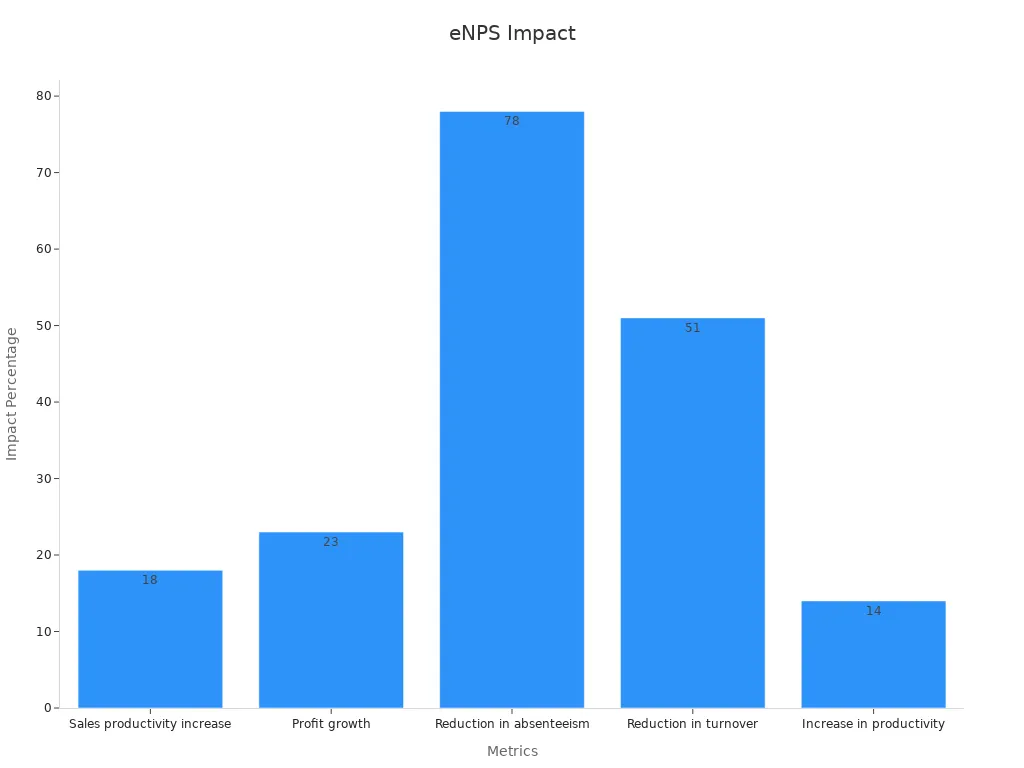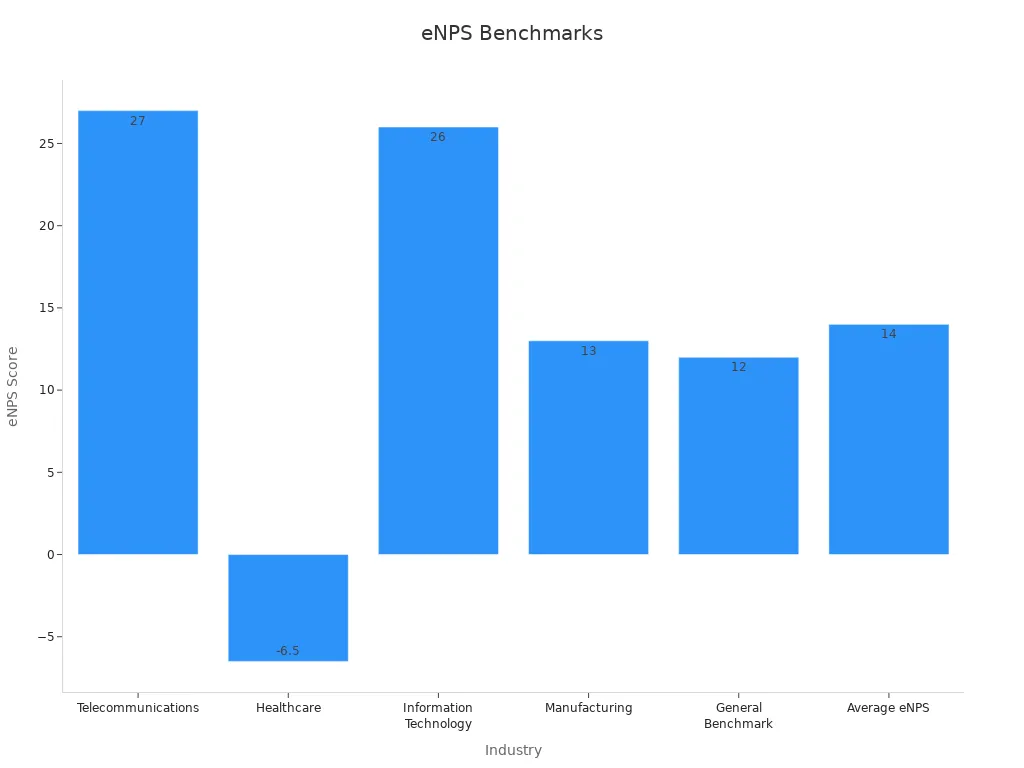Why Employee Net Promoter Score Matters for Workplace Success

Understanding why Employee Net Promoter Score (eNPS) matters can transform how you view workplace success. This metric measures employee satisfaction by categorizing them as promoters, passives, or detractors. Companies with eNPS scores above 70 often boast exceptional workplace cultures, while scores below 0 reveal dissatisfaction. Higher scores also correlate with lower turnover rates, showing how employee sentiment impacts retention. Employee satisfaction is as vital as customer satisfaction for business success. By tracking eNPS, you gain insights into engagement levels and create a thriving work environment.
Key Takeaways
Employee Net Promoter Score (eNPS) shows how happy workers are. It groups them as promoters, passives, or detractors.
High eNPS means fewer people quit and work gets done faster. Happy workers help businesses do well.
Checking eNPS often helps find out how workers feel. This lets companies fix problems and make the workplace better.
Listening to workers' ideas builds trust and loyalty. This makes workers care more and do a better job.
Helping workers grow and feel good boosts eNPS. A caring workplace inspires workers to do their best.
What Is Employee Net Promoter Score (eNPS)?

Definition and Purpose of eNPS
Employee Net Promoter Score (eNPS) is a simple yet powerful metric that measures employee satisfaction and loyalty. It is derived from the Net Promoter Score (NPS), which businesses use to assess customer loyalty. eNPS asks employees a single question: "How likely are you to recommend this organization as a great place to work?" Employees respond on a scale from 1 to 10, with their answers categorizing them as promoters, passives, or detractors.
This metric serves multiple purposes. It quantifies employee engagement and satisfaction, offering a clear picture of workplace morale. Organizations with highly engaged employees often see significant benefits. For example, research shows that companies with engaged teams are 23% more profitable. Regularly tracking eNPS allows HR teams to benchmark engagement levels and evaluate the success of their initiatives. By identifying areas for improvement, you can create a more supportive and productive work environment.
Why eNPS Matters for Workplace Success
Understanding why Employee Net Promoter Score (eNPS) matters can transform your workplace. High eNPS scores indicate engaged, satisfied, and loyal employees. These employees are more likely to contribute innovative ideas, deliver excellent customer service, and foster a positive work culture. On the other hand, disengaged employees can lower team morale and productivity.
The impact of eNPS on workplace success is backed by data. For instance, companies with low-engagement teams experience turnover rates that are 18% to 43% higher than those with highly engaged teams. Measuring eNPS provides actionable insights, helping you address employee concerns before they escalate. Additionally, eNPS is a fast and effective way to monitor engagement continuously, ensuring your organization stays on track.
The benefits of a strong eNPS extend beyond employee satisfaction. Metrics show that engaged employees drive a 14% increase in productivity, a 23% boost in profit growth, and a 51% reduction in turnover. These outcomes highlight why Employee Net Promoter Score (eNPS) matters for achieving workplace success.

How Is eNPS Calculated?
The eNPS Formula
The Employee Net Promoter Score (eNPS) formula is straightforward. It calculates employee satisfaction by subtracting the percentage of detractors from the percentage of promoters. Passives are excluded from the calculation. The formula looks like this:
eNPS = (% of Promoters - % of Detractors) x 100
This method provides a single score ranging from -100 to +100. A positive score indicates more promoters than detractors, while a negative score signals dissatisfaction. For example, if 60% of employees are promoters and 20% are detractors, the eNPS would be 40. This simplicity makes eNPS a reliable tool for quickly assessing workplace sentiment.
Promoters, Passives, and Detractors
To calculate eNPS, you first categorize employees into three groups based on their responses to the question, "How likely are you to recommend this organization as a great place to work?"
Promoters (9–10): These employees are highly engaged and enthusiastic. They actively promote the company and contribute to a positive work culture.
Passives (7–8): These employees are satisfied but not fully engaged. They are less likely to advocate for the company and may leave for better opportunities.
Detractors (0–6): These employees are disengaged and dissatisfied. They can negatively impact morale and productivity.
Role | Score Range | Description |
|---|---|---|
Promoters | 9 to 10 | Highly engaged employees who actively promote the company and have few complaints. |
Passives | 7 to 8 | Satisfied employees who are neither highly engaged nor disengaged, with minor issues. |
Detractors | 0 to 6 | Disengaged employees who can negatively impact the company and are likely to express dissatisfaction. |
Understanding these categories helps you identify areas needing improvement and focus on strategies to boost engagement.
Example of eNPS in Action
Let’s look at a real-world example. Company A initially had an eNPS of -5, indicating more detractors than promoters. After implementing better communication practices and offering development opportunities, their eNPS rose to +20. This improvement significantly reduced turnover rates and boosted employee morale.
Company | Initial eNPS | Final eNPS | Impact on Turnover | Additional Notes |
|---|---|---|---|---|
Company A | -5 | +20 | Decreased | Improved communication and development opportunities |
This example shows how tracking eNPS can lead to actionable insights and measurable improvements. By addressing employee concerns, you can create a more engaged and loyal workforce. This is why Employee Net Promoter Score (eNPS) matters for workplace success.
What Is a Good eNPS Score?
Understanding eNPS Benchmarks
A good eNPS score varies across industries, reflecting differences in workplace dynamics and employee expectations. For example, industries like technology and professional services often achieve higher scores due to their focus on innovation and employee development. In contrast, sectors like healthcare and government typically see lower scores due to unique challenges such as high stress or bureaucratic constraints.
Here’s a breakdown of eNPS benchmarks by industry:
Industry | eNPS Score Range |
|---|---|
Technology (Software/Biotech) | 30 to 40 |
Financial Services | 15 to 25 |
Healthcare | 10 to 20 |
Construction | 10 to 20 |
Retail | 20 to 30 |
Hospitality | 15 to 25 |
Manufacturing | 20 to 30 |
Professional Services | 25 to 35 |
Real Estate | 15 to 25 |
Education | 0 to 10 |
Transportation and Logistics | 20 to 30 |
Energy (Oil, Gas, Renewable) | 15 to 25 |
Entertainment | 15 to 25 |
Non-Profit | 10 to 20 |
Government | 5 to 15 |
Outstanding eNPS scores, typically between 50 and 70, indicate exceptional employee satisfaction and loyalty. Scores above 80 place organizations in the top 1% of workplaces globally.

Factors That Influence eNPS
Several factors can impact your eNPS, making it essential to understand what drives employee sentiment. These include:
Cultural differences: Employees from different regions may respond differently to surveys, affecting scores.
Workplace elements: Compensation, leadership, and company culture all play a role in shaping employee advocacy.
Response biases: Social desirability and extreme response bias can distort results, making it crucial to interpret scores carefully.
By addressing these factors, you can create a more accurate and actionable eNPS strategy.
Interpreting Positive, Neutral, and Negative Scores
Positive, neutral, and negative eNPS scores provide valuable insights into employee engagement. Positive scores (above 0) indicate more promoters than detractors, signaling a generally satisfied workforce. Neutral scores (around 0) suggest a balance between satisfied and dissatisfied employees, highlighting areas for improvement. Negative scores (below 0) reveal significant dissatisfaction, requiring immediate action to address employee concerns.
However, it’s important to note that eNPS doesn’t account for passive employees, who can significantly influence overall engagement. Additionally, the 11-point scale used in eNPS surveys may lead to unclear distinctions in responses. Some organizations find that a five-point scale offers a clearer picture of employee sentiment.
Understanding these nuances helps you interpret eNPS scores effectively and take meaningful steps to improve workplace satisfaction.
Why Tracking eNPS Is Important
Benefits of Regular eNPS Monitoring
Tracking eNPS regularly provides valuable insights into employee satisfaction and engagement. By incorporating eNPS questions into employee reviews and exit interviews, you can quickly identify and address issues that impact retention and brand reputation. Regular surveys also allow you to monitor trends and pinpoint areas for improvement. For example, organizations that administer eNPS surveys consistently can benchmark their scores against industry standards, gaining a clearer understanding of their workplace dynamics.
Evidence Description | Source |
|---|---|
Additionally, eNPS fosters an environment for genuine feedback, boosting employee morale. Its simplicity ensures high participation rates, making it an efficient tool for gathering actionable insights. Over time, this data enables long-term benchmarking and helps organizations track progress toward their engagement goals.
Impact on Employee Engagement and Retention
High eNPS scores correlate with better employee engagement and retention. Engaged employees are more likely to stay with your organization, reducing turnover and associated costs. For instance, companies with high eNPS scores often report stronger employer branding and healthier workplace cultures. This creates a positive feedback loop where engaged employees contribute to a thriving work environment, further enhancing retention.
Source | Key Findings |
|---|---|
Inspirus | High eNPS scores correlate with higher retention rates and better overall performance. |
ThriveSparrow | High eNPS indicates a healthy workplace with engaged employees, linked to better retention and productivity. |
Guru | eNPS analysis helps gauge employee engagement and uncover opportunities for improving retention. |
Regular eNPS tracking also uncovers opportunities to improve the employee experience. By addressing concerns early, you can create a workplace where employees feel valued and motivated to contribute their best efforts.
How eNPS Drives Business Success
Employee engagement, measured through eNPS, directly impacts business success. Engaged employees deliver better customer experiences, leading to higher satisfaction and loyalty. For example, companies like Lowe’s and Apple have successfully used eNPS to measure engagement and improve customer outcomes. High eNPS scores also correlate with increased productivity and financial performance, making it a critical metric for organizational growth.
Key Metrics | Description | Impact on Business |
|---|---|---|
Employee Engagement | Higher engagement leads to better customer feedback. | Increases customer satisfaction and loyalty. |
Customer Satisfaction | Positive feedback from engaged teams. | Drives overall business performance. |
eNPS | Measures employee willingness to recommend the company. | Correlates with improved customer experiences. |
To leverage eNPS effectively, define measurable goals, assess current engagement levels, and implement strategies based on survey results. This approach ensures continuous improvement and positions your organization for long-term success.
How to Improve Your eNPS

Acting on Employee Feedback
Acting on employee feedback is one of the most effective ways to improve your eNPS. When employees see their input leading to meaningful changes, they feel valued and engaged. Start by ensuring that your eNPS surveys are anonymous. This encourages honest responses and helps you identify genuine concerns.
Once you collect feedback, prioritize the issues that impact employee satisfaction the most. For example:
Address recurring complaints about leadership or communication gaps.
Implement urgent reminders for surveys to increase participation rates.
Use analytics to track how employees engage with eNPS communications and refine your follow-up strategies.
Organizing feedback in a centralized system can also improve efficiency. It ensures accountability and makes it easier to track progress over time. By taking these steps, you show employees that their voices matter, which fosters trust and loyalty.
Tip: Employees are more likely to provide honest feedback when they know their concerns will lead to action.
Building a Culture of Open Communication
Open communication plays a vital role in improving eNPS. When employees feel heard, they are more likely to stay engaged and satisfied. A transparent workplace encourages innovation, reduces misunderstandings, and promotes problem-solving.
Evidence Type | Description |
|---|---|
Open Communication | Enhances engagement, fosters transparency, and encourages collaboration. |
eNPS Improvement | Creates a supportive environment that significantly boosts eNPS scores. |
To build this culture, encourage managers to hold regular one-on-one meetings. Train leaders to listen actively and respond constructively. Recognize employee contributions publicly to show appreciation. These practices create a positive work environment where employees feel valued and motivated.
Conducting Consistent eNPS Surveys
Regular eNPS surveys help you track trends and identify areas for improvement. Consistency ensures that you maintain a pulse on employee satisfaction. Higher participation rates lead to more accurate data, richer insights, and better benchmarking opportunities.
Evidence Type | Description |
|---|---|
Data Accuracy | Reflects sentiments of a broader employee base, enhancing reliability. |
Tailored Interventions | Identifies specific concerns, enabling targeted solutions. |
Case Study: Buffer | Found that employees who feel heard are 4.6 times more likely to engage, reducing project delays. |
Make surveys accessible on mobile devices to increase response rates. Follow up on results with actionable steps to show employees that their feedback drives change. Over time, consistent surveys build trust and improve organizational buy-in, creating a more engaged workforce.
Note: Employees who feel heard are more likely to contribute positively, boosting overall workplace satisfaction.
Investing in Employee Development and Well-Being
Investing in employee development and well-being is one of the most effective ways to boost your eNPS. Employees who feel supported in their growth and health are more likely to stay engaged and loyal. This investment shows that you value their contributions and care about their future.
Why Employee Development Matters
Providing opportunities for learning and growth helps employees feel empowered. When you offer training programs, mentorship, or skill-building workshops, employees gain confidence in their abilities. This confidence translates into higher productivity and job satisfaction.
Tip: Create personalized development plans for employees to align their goals with your organization’s objectives.
The Role of Well-Being in Engagement
Employee well-being goes beyond physical health. It includes mental and emotional wellness too. A supportive work environment that promotes work-life balance can reduce stress and burnout. Offering flexible schedules, wellness programs, or mental health resources can make a big difference.
Well-Being Initiative | Impact on Employees |
|---|---|
Flexible Work Hours | Reduces stress and improves focus |
Wellness Programs | Encourages healthy habits |
Mental Health Resources | Supports emotional resilience |
How to Get Started
Start by asking employees what they need. Use surveys or one-on-one meetings to gather feedback. Then, implement programs that address their concerns. For example, if employees want more career growth, introduce leadership training. If they value wellness, consider gym memberships or mindfulness sessions.
Employees thrive when they see that their well-being is a priority. This leads to higher engagement and a stronger eNPS.
By focusing on development and well-being, you create a workplace where employees feel valued and motivated to succeed.
Employee Net Promoter Score (eNPS) serves as a vital tool for understanding and improving workplace dynamics. High eNPS scores reflect a positive work environment where employees feel engaged and loyal. This directly impacts productivity, innovation, and overall business performance.
Measuring eNPS offers insights into employee loyalty, which strengthens company culture and drives workplace success. Organizations with strong eNPS scores often achieve higher profits and brand equity.
By prioritizing eNPS, you create a thriving workforce that supports long-term growth and success. Start tracking today to unlock your organization’s full potential.
FAQ
What is the ideal frequency for conducting eNPS surveys?
You should conduct eNPS surveys quarterly or biannually. This frequency ensures you capture trends and address issues promptly. Regular surveys also help you track the impact of changes made based on employee feedback.
Can eNPS replace traditional employee engagement surveys?
No, eNPS complements traditional surveys. While eNPS provides a quick snapshot of employee sentiment, traditional surveys offer deeper insights into specific areas like leadership, culture, and benefits. Use both for a comprehensive understanding.
How can I encourage employees to participate in eNPS surveys?
Make surveys anonymous to ensure honest feedback. Communicate the purpose clearly and explain how their input drives change. Use reminders and incentives, like small rewards, to boost participation rates.
What should I do if my eNPS score is negative?
Focus on identifying and addressing key issues. Analyze feedback to understand employee concerns. Prioritize areas like leadership, communication, and well-being. Implement changes and communicate progress to rebuild trust and engagement.
Is a high eNPS score always a sign of success?
Not always. A high score reflects satisfaction but doesn’t guarantee long-term engagement. Combine eNPS with other metrics, like retention rates and productivity, to get a complete picture of workplace success.
See Also
Enhance Employee Productivity With Effective Talent Management Tools
Improving Employee Satisfaction With MokaHR’s Management Solutions
Discover New Opportunities With MokaHR’s Talent Management Platform
Utilizing Applicant Tracking Systems To Monitor Key Performance Indicators
From recruiting candidates to onboarding new team members, MokaHR gives your company everything you need to be great at hiring.
Subscribe for more information

